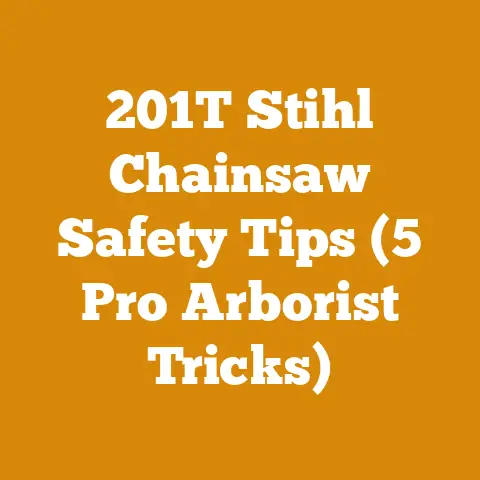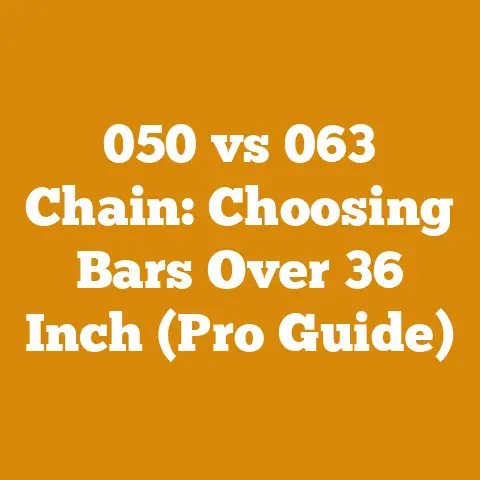Eddie Bauer Boots for Wood Processing (5 Must-Know Gear Tips)
It’s estimated that over 70 million cords of firewood are burned annually in the United States alone. Selecting the right gear for wood processing, especially appropriate footwear, is crucial for safety and efficiency. I’ve spent years in the woods, felling trees, milling lumber, and preparing firewood. I’ve learned firsthand that the right pair of boots can make or break your day. This guide focuses specifically on Eddie Bauer boots and offers five essential gear tips to consider when processing wood.
Eddie Bauer Boots for Wood Processing: 5 Must-Know Gear Tips
Choosing the right boots for wood processing is more than just grabbing any pair off the shelf. It’s about safety, comfort, and performance. Eddie Bauer boots, known for their durability and quality, can be a solid choice if you know what to look for. I’ll walk you through five critical aspects to consider, drawing on my experiences in the field.
1. Prioritize Safety Features: Steel Toe and Ankle Support
Safety is paramount when handling heavy logs, sharp tools, and unpredictable terrain. This is where a good pair of boots become essential personal protective equipment (PPE).
-
Steel Toe Protection: A steel toe is non-negotiable. It protects your feet from crushing injuries caused by falling logs or dropped tools. I once saw a colleague drop a maul on his foot while splitting wood. Luckily, his steel-toe boots prevented a serious injury. Look for boots that meet or exceed ANSI safety standards (American National Standards Institute). These standards ensure the steel toe can withstand significant impact and compression.
-
Ankle Support: Working in uneven terrain puts your ankles at risk. High-cut boots that provide ample ankle support are crucial. The support minimizes the risk of sprains and strains, especially when carrying heavy loads. I’ve learned this the hard way after a few ankle twists on slippery slopes. Look for boots with reinforced ankle padding and a snug fit around the ankle area.
-
Metatarsal Guards (Optional but Recommended): For even more protection, consider boots with metatarsal guards. These protect the top of your foot from impact. While not always necessary, they provide an extra layer of safety, especially when working with heavy machinery or in areas with a high risk of falling debris.
My Experience: I remember one time when a small log rolled off a stack and landed directly on my foot. The steel toe in my boots saved me from a potentially broken foot. Since then, I’ve always emphasized the importance of steel-toe protection to anyone working with wood.
Takeaway: Don’t compromise on safety. Steel-toe protection and ankle support are essential features for wood processing boots.
2. Evaluate Sole Traction and Grip: Lug Pattern and Material
The sole of your boot is your primary point of contact with the ground. Adequate traction and grip are essential for preventing slips and falls, especially on uneven, muddy, or icy surfaces.
-
Lug Pattern: The lug pattern is the design of the treads on the sole. Deeper and wider lugs provide better traction in loose soil, mud, and snow. Aggressive lug patterns are ideal for logging and firewood preparation. I’ve found that a multi-directional lug pattern offers the best grip in various conditions.
-
Sole Material: The material of the sole also affects traction. Rubber soles are a common choice, offering a good balance of grip and durability. However, specialized rubber compounds, such as those found in Vibram soles, provide superior grip and abrasion resistance. These are worth the investment if you work in challenging conditions.
-
Slip Resistance Rating: Look for boots with a slip-resistance rating. This rating indicates how well the sole performs on various surfaces. A higher rating means better slip resistance. Check the manufacturer’s specifications for details.
My Experience: I once tried to save money by buying cheap boots with a smooth sole. It was a disaster. I slipped and fell multiple times, especially on wet logs. I quickly learned that investing in quality boots with a good lug pattern is worth every penny.
Case Study: A study by the National Institute for Occupational Safety and Health (NIOSH) found that slip-resistant footwear significantly reduces the risk of slip and fall injuries in the workplace. The study emphasized the importance of selecting footwear with appropriate tread patterns and materials for the specific work environment.
Takeaway: Prioritize boots with aggressive lug patterns and high-quality sole materials for optimal traction and grip.
3. Assess Comfort and Fit: Proper Sizing and Arch Support
Comfort is crucial when you’re on your feet for hours. Ill-fitting boots can lead to blisters, foot pain, and fatigue, impacting your productivity and overall well-being.
-
Proper Sizing: Get your feet professionally measured to ensure you’re wearing the correct size. Remember that foot size can change over time, so it’s a good idea to get measured periodically. Wear the same socks you’ll be wearing while working when you get measured.
-
Arch Support: Adequate arch support is essential for preventing foot pain and fatigue. If you have high or low arches, consider using orthotic inserts to provide additional support. I personally use custom orthotics in my work boots, which has made a huge difference in my comfort levels.
-
Break-In Period: New boots often require a break-in period. Wear them for short periods initially to allow them to mold to your feet. Use a leather conditioner to soften the leather and reduce stiffness.
-
Lacing System: Pay attention to the lacing system. A good lacing system allows you to customize the fit and provide secure support. Look for boots with sturdy eyelets and durable laces. Speed hooks can also be helpful for quick lacing and unlacing.
My Experience: I once spent a week working in boots that were a half-size too small. By the end of the week, my feet were covered in blisters, and I could barely walk. I learned the importance of proper sizing the hard way.
Tip: Try on boots at the end of the day when your feet are slightly swollen. This will help you ensure you’re getting a comfortable fit.
Takeaway: Invest in boots that fit properly and provide adequate arch support for all-day comfort.
4. Evaluate Durability and Material: Leather vs. Synthetic
The durability of your boots depends on the materials used in their construction. Leather and synthetic materials each have their pros and cons.
-
Leather Boots: Leather boots are known for their durability, water resistance, and breathability. Full-grain leather is the most durable type of leather, followed by top-grain leather. Leather boots can withstand harsh conditions and provide excellent support. However, they require regular maintenance, such as cleaning and conditioning, to keep them in good condition.
-
Synthetic Boots: Synthetic boots are typically lighter and more affordable than leather boots. They are also easier to clean and maintain. However, they may not be as durable or water-resistant as leather boots. Look for synthetic materials that are abrasion-resistant and waterproof.
-
Construction Method: The construction method also affects durability. Goodyear welt construction is a durable method that allows the soles to be replaced. This extends the life of the boots. Cemented construction is a less expensive method, but the soles cannot be replaced.
My Experience: I’ve owned both leather and synthetic boots. While synthetic boots are lighter, I’ve found that leather boots hold up better in the long run, especially when exposed to rough terrain and heavy use.
Statistic: A study by the U.S. Department of Agriculture found that leather boots last an average of 2-3 years with proper care, while synthetic boots typically last 1-2 years.
Takeaway: Choose boots made from durable materials, such as full-grain leather, and consider the construction method for long-lasting performance.
5. Consider Water Resistance and Breathability: Waterproof Membranes and Ventilation
Working in wet conditions can lead to discomfort, blisters, and even hypothermia. Water-resistant or waterproof boots are essential for keeping your feet dry.
-
Waterproof Membranes: Look for boots with waterproof membranes, such as Gore-Tex. These membranes allow moisture to escape while preventing water from entering. This helps keep your feet dry and comfortable.
-
Water-Resistant Treatments: Leather boots can be treated with water-resistant coatings to repel water. Reapply these treatments regularly to maintain their effectiveness.
-
Breathability: Breathability is also important. Boots that are too hot and stuffy can lead to sweaty feet, which can increase the risk of blisters. Look for boots with breathable linings and ventilation features.
-
Height of the Boot: The height of the boot can also affect water resistance. Higher boots provide more protection from water and mud. However, they may be less breathable than lower boots.
My Experience: I once spent a day working in the rain with boots that weren’t waterproof. By the end of the day, my feet were soaked, and I was shivering. I learned that investing in waterproof boots is essential for working in wet conditions.
Tip: Use waterproof socks for added protection, especially when working in extremely wet conditions.
Takeaway: Prioritize boots with waterproof membranes and breathable linings to keep your feet dry and comfortable in all weather conditions.
Additional Considerations for Wood Processing Boots
Beyond the five essential tips, here are some additional factors to consider when selecting Eddie Bauer boots for wood processing:
Insulation
If you work in cold climates, consider insulated boots to keep your feet warm. Insulation is measured in grams. Higher gram ratings provide more warmth. I recommend at least 400 grams of insulation for cold weather.
Shank
The shank is a piece of material that runs between the insole and outsole. It provides support and stability. Steel or nylon shanks are common choices. Steel shanks provide more support, while nylon shanks are lighter.
Weight
The weight of the boots can affect your fatigue levels. Lighter boots are generally more comfortable for long days on your feet. However, lighter boots may not be as durable as heavier boots.
Price
Boot prices can vary widely. Set a budget and stick to it. Remember that investing in quality boots is worth it in the long run. They will last longer and provide better protection and comfort.
Brand Reputation
Consider the brand’s reputation. Eddie Bauer is a reputable brand known for its quality and durability. Read reviews and ask for recommendations from other wood processors.
Maintenance
Proper maintenance is essential for extending the life of your boots. Clean them regularly and apply leather conditioner as needed. Store them in a cool, dry place.
Sock Choice
Your sock choice can also affect comfort and performance. Wear moisture-wicking socks to keep your feet dry. Avoid cotton socks, which can trap moisture and lead to blisters. I prefer wool or synthetic socks.
Wood Processing Tasks and Boot Requirements
The specific tasks you perform will also influence your boot requirements.
- Felling Trees: Requires boots with excellent ankle support, steel-toe protection, and aggressive lug patterns.
- Skidding Logs: Requires durable boots with good traction and water resistance.
- Milling Lumber: Requires boots with steel-toe protection and comfortable insoles.
- Splitting Firewood: Requires boots with steel-toe protection and good traction.
- Stacking Firewood: Requires boots with good ankle support and comfortable insoles.
Eddie Bauer Boot Models to Consider
While specific models change over time, here are some Eddie Bauer boot characteristics that align well with wood processing needs:
-
K-6 Boot: Designed for hiking and backpacking, the K-6 boot often features full-grain leather, a waterproof membrane, and a durable Vibram sole. These features make it suitable for rugged outdoor work. Look for models with steel-toe options.
-
Traverse Boot: The Traverse boot line often emphasizes comfort and durability. Models with high ankle support and aggressive lug patterns could be a good fit.
-
Guide Pro Boot: Designed for guides who spend long days outdoors, these boots often prioritize durability, weather protection, and support.
Always check the specific features of each model to ensure it meets your needs. Look for steel-toe options, high ankle support, and aggressive lug patterns.
Wood Processing Safety: Beyond the Boots
While good boots are essential, remember that safety is a multifaceted issue. Here are some additional safety tips for wood processing:
- Wear appropriate PPE: This includes safety glasses, hearing protection, gloves, and chaps.
- Use tools properly: Follow the manufacturer’s instructions and use tools only for their intended purpose.
- Maintain your tools: Keep your tools sharp and in good working condition.
- Be aware of your surroundings: Watch out for hazards such as falling branches, uneven terrain, and wildlife.
- Take breaks: Avoid fatigue by taking regular breaks.
- Work with a partner: When possible, work with a partner to provide assistance and ensure safety.
- First-aid Kit: Always keep a well-stocked first-aid kit on-site.
Measuring Success in Wood Processing
How do you know if you’re doing a good job with wood processing? Here are some metrics to consider:
- Processing Time: Track how long it takes you to process a cord of wood. Over time, you should become more efficient.
- Moisture Content: Use a moisture meter to measure the moisture content of your firewood. Aim for 20% or less for optimal burning.
- Safety Record: Keep track of any accidents or injuries. A good safety record is a sign of a well-run operation.
- Customer Satisfaction: If you’re selling firewood, track customer satisfaction. Happy customers are more likely to return.
- Equipment Maintenance: Keep a schedule for maintaining your equipment. Regular maintenance will extend the life of your equipment and prevent breakdowns.
Common Mistakes to Avoid
Here are some common mistakes to avoid when processing wood:
- Using dull tools: Dull tools are more dangerous and less efficient.
- Working when fatigued: Fatigue increases the risk of accidents.
- Ignoring safety precautions: Always follow safety precautions.
- Overloading equipment: Don’t overload your equipment. This can damage it and create a safety hazard.
- Neglecting maintenance: Regular maintenance is essential for keeping your equipment in good working condition.
- Improper stacking: Stacking firewood improperly can create a fire hazard.
The Future of Wood Processing
The future of wood processing is likely to involve more automation and technology. Here are some trends to watch:
- Robotics: Robots are already being used in some logging operations. They can perform tasks such as felling trees and skidding logs.
- Drones: Drones can be used to survey forests and identify areas that need to be harvested.
- GPS Technology: GPS technology can be used to track logs and improve efficiency.
- Electric Chainsaws: Electric chainsaws are becoming more powerful and efficient. They are also quieter and produce fewer emissions than gas-powered chainsaws.
- Automated Log Splitters: Automated log splitters can split wood faster and more efficiently than manual log splitters.
Conclusion
Choosing the right boots for wood processing is a critical investment in your safety, comfort, and productivity. By prioritizing safety features, evaluating sole traction, assessing comfort, considering durability, and ensuring water resistance, you can select Eddie Bauer boots that meet the demands of the job. Remember to consider additional factors such as insulation, shank, weight, and price. And always prioritize safety by wearing appropriate PPE and following safe work practices. With the right gear and a commitment to safety, you can enjoy the rewarding experience of wood processing for years to come. Remember, your feet are your foundation in this demanding work; treat them well, and they’ll support you through thick and thin (or, more accurately, through mud and wood).






